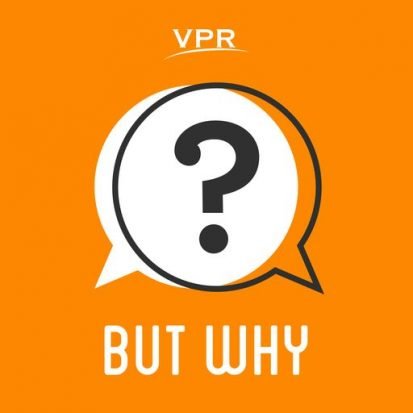
How did people keep food cold in olden times?
Leave a reviewViolet, 5, wants to know: what was life like before refrigerators? And Ellinor, 6, asks: how did they make ice in the old times? In this episode, we learn about the history of ice harvesting and the industry that built up around it, where ice cut from lakes in New England was shipped to as far away as India and the Caribbean. We hear more about this history from Gavin Weightman, author of The Frozen Water Trade. And we visit Rockywold-Deephaven Camps in New Hampshire, where ice is still harvested each winter from Squam Lake and used to keep old fashioned ice boxes at the camp cool all summer long.
© Vermont Public Radio | 23:56
|Episode: 174 |
Full episode description
 Episode One: But Why: Intro For Adults
Episode One: But Why: Intro For Adults
This is an Episodic show. You can listen to it in any order, but episode one is always a great place to start.Full Episode description
Violet, 5, wants to know: what was life like before refrigerators? And Ellinor, 6, asks: how did they make ice in the old times? In this episode, we learn about the history of ice harvesting and the industry that built up around it, where ice cut from lakes in New England was shipped to as far away as India and the Caribbean. We hear more about this history from Gavin Weightman, author of The Frozen Water Trade. And we visit Rockywold-Deephaven Camps in New Hampshire, where ice is still harvested each winter from Squam Lake and used to keep old fashioned ice boxes at the camp cool all summer long.
Download our learning guides: PDF | Google Slide | Transcript
Before refrigeration, people stored food in a lot of different ways. Food would be smoked, dried, salted, fermented or pickled. It would also be kept in root cellars or pits underground.
Wealthy people who lived in cold climates were more likely to have an ice pit or later an ice house where they would keep ice for use in warm months.
In the 1800s, a Massachusetts man named Frederic Tudor thought he could get wealthy by shipping ice to warmer climates. After trying and failing many times, he finally succeeded in convincing people that there was a market for ice and wound up shipping ice around the world, as far away as India. The ice was kept cold by insulating it with straw and sawdust and stored in warehouses until it was time to be used.
People cut ice from lakes using hand saws. Eventually they started using horse drawn machinery to cut ice, but it was still hard and dangerous work.
People in cities also became accustomed to ice as an everyday necessity, and eventually, naturally harvested ice was eventually replaced by ice made in factories. In cities, “ice men” would deliver ice to butchers and fishmongers, and to individual houses, where people would use them in their ice boxes.
Ice boxes were wooden or metal chests with a compartment in the top where a block of ice would be placed. Cold air falls and cools the food below it. Ice boxes needed more ice every day or two.
The electric refrigerator was invented in the early 1900s and became popular by 1940.
Resources
© Vermont Public Radiobop| Status: Active, 261 episodes | Kind: Episodic | Episode URL
The content, Artwork and advertising within this podcast is not owned or affiliated with Sound Carrot and remain the property of their respective owners.








